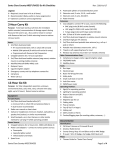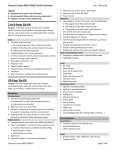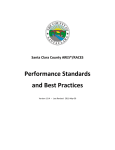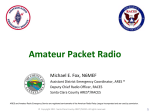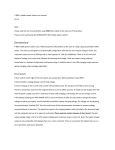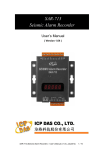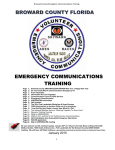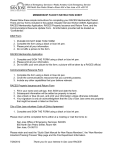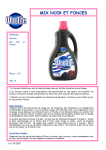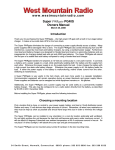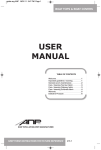Download 2-Hour Carry Kit 12-Hour Go Kit
Transcript
Santa Clara County ARES®/RACES Go Kit Checklists Legend: X = Required (must have in kit at all times) R = Recommended (likely needed on most assignments) O = Optional (useful on some assignments) 2-Hour Carry Kit Purpose: To be kept nearby at all times for immediate (within minutes) communication of damage reports during Resource Net Level 1 ops. Also used to remain in contact with Resource Net Level 2 while returning home to retrieve 12-hour Go-Kit. Items: X 2m/70cm dual-band radio • HT recommended (min. 5W on 12V/2.5W on batt) • Mobile 25W optional (if vehicle will not be far away) • Programmed with Resource Net frequencies X Charged batteries for 2-3 hours operation X Mobile antenna (mag mount or existing mobile antenna) X Modified Mercalli (Mike-Mike) scale X Notepad / pens R Cigarette lighter adapter R Emergency county and city telephone contact list R Cell phone R Water (16 oz.) 12-Hour Go Kit Purpose: For fully independent operation; unknown environment (heat, cold, wind, rain); unknown time (day, night, up to 12 hours). Return home to retrieve. Equipment Portable Radio: X 2m/70cm dual-band handie-talkie (HT) • minimum 5W on 12V/2.5W on batteries [Note 1] • dual-receive recommended X Radio user manual or cheat sheet X Earbud or headphones minimum; headset, earbud/mic, or speaker/mic/earbud, or similar recommended R Small backpack, vest, chest harness or other similar method for carrying HT while operating portable Power Source: X Charged batteries for 12 hours (min. 3000 mAH) [Note 2] X Power cord adapters – connect to various power sources: • Powerpoles • Cigarette lighter socket • Vehicle battery terminals X Spare fuses R Powerpole splitter or fused distribution panel Santa Clara County ARES®/RACES Rev: 2009-Oct-17 R Extension cord, 3-wire, 3-6 ft., multi-outlet O Extension cord, 3-wire, 50-100 ft. O Power Inverter Antennas: R 2m/70cm high gain HT antenna X 2m/70cm dual-band magnetic mount antenna R 2m/70cm dual-band portable base antenna (e.g. roll-up Jpole or other) R Portable mast (elevates antenna min. 10 ft.) R Tripod or self-supporting base for mast R Window clip antenna mount X Coax adapters to connect HT to existing antennas: • BNC plug (male) & BNC socket (female) • UHF plug (PL-259) & UHF socket (SO-239) • N-type plug (male) and N-type socket (female) Other Communications Gear: R Cell phone & charger and/or cigarette lighter adapt. O FRS/GMRS Radio O Satellite phone Tools: R Duct tape R Electrical tape R Nylon Tie-Wraps/wire ties R Utility knife R Small multi-tool or tool kit O Volt-Ohm meter O SWR/Power meter Operating Position: X Sign(s) for operating position R Lighting for operating position R Rope or Dacron cord (50’) R Folding chair O Magnetic sign for car O Folding table O Pop-up Canopy O Tarp (8’ by 8’ or larger) O Folding cart O Safety strobes or flares O Caution/flagging tape (for marking cables, antennas, …) Documentation Identification: X CA Driver’s license or CA-issued ID card X Amateur Radio license X County DSW card X SCCo-issued ID badge; other city badges Maps: X Thomas Guide for Santa Clara County X Compass or GPS R Maps of antenna locations (if available) Page 1 of 4 Santa Clara County ARES®/RACES Go Kit Checklists Rev: 2009-Oct-17 R City, county or other detail maps Forms: X Modified Mercalli (Mike-Mike) scale X ICS 205-SCCo – Communications Plan (min. 5) X ICS 211A-SCCo – Communications Check-In (min. 5) X ICS 213-SCCo – Message (min. 10) X ICS 214-SCCo – Unit Activity Log (min. 5) X ICS 309-SCCo – Communications Log (min. 5) X ICS 314-SCCo – Windshield Survey (min. 5) R Phone message pad (2-part style recommended) Logging / Note taking: X Clipboard (covered type recommended) X Notepads (standard or waterproof) X At least 2 pens / pencils O Highlighters / felt-tip pens Contact Lists: X SCCo Frequency List X Emergency county and city telephone contact list X Police/Fire direct dial phone numbers O Repeater directory X Food for 12 hours (make your own list) X Water for 12 hours (3-4 quarts recommended) R Small cooler or ice chest Toiletries: R Hand soap and/or sanitizer R Toilet paper O Tylenol O Antacid tablets As Needed / Appropriate: - Prescription medication - List of medication used - Eyeglasses & spare Personal Gear Mobile Radio Kit (as needed) Vehicle: X Reliable operating condition X Fueled – minimum ½ full at all times R Jumper cables General Items: X Money (paper and coin) – in case ATMs are down X Watch or clock R Trash bags Personal Safety Gear: X Flashlight or headlamp and spare batteries for 12 hours X Safety vest, ANSI standard (lime yellow recommended) R First Aid kit R Whistle R Work gloves R Sunglasses R Sunscreen lotion R Insect Repellent R Safety glasses R Mask (NIOSH-certified N95 or better) O Hearing protection (e.g. foam ear plugs) O Hard hat (lime yellow recommended) O Chemical light sticks Clothing: X Sturdy, closed-toe shoes (no sandals) X Long pants (no shorts) X Hat (broad brim recommended) X Seasonal jacket / rain gear Food & Water: - Santa Clara County ARES®/RACES Miscellaneous (as needed) - - - Portable AM radio and spare batteries Binoculars Baggies to seal/protect items Shovel Fire extinguisher Disposable camera 2m/70cm mobile radio • 25W minimum • Dual-receive, cross-band repeat recommended Radio user manual or cheat sheet Headset (stereo recommended for VFO per ear) Battery for 12-hours operation (20 AH min.; 26 AH rec.) Battery charger Power cord adapters – connect to various power sources: • Powerpoles • Cigarette lighter socket • Vehicle battery terminals Coax adapters to connect mobile to existing antennas: • BNC plug (male) & BNC socket (female) • UHF plug (PL-259) & UHF socket (SO-239) • N-type plug (male) and N-type socket (female) Packet Equipment (as needed) - Laptop with Outpost and PacFORMS installed USB flash drive (i.e. USB key) TNC (may be hardware, software or built into radio) Cables: TNC to radio; TNC to PC Shade cover for display Portable printer Entire station can operate for min. 1 hr on battery Page 2 of 4 Santa Clara County ARES®/RACES Go Kit Checklists Rev: 2009-Oct-17 Extended Go Kit Purpose: Additional items for fully independent operation over an extended period of time. Used in situations where returning home after shift is not possible or not ideal. Personal Go Kit Items/Notes: As Needed Power Source: - Regulated DC power supply - Battery charger - Spare batteries (for charging while operating) - Portable generator and fuel - DC distribution panel & cables (Powerpoles recommended) Clothing: - Rain gear - Jacket - Warm clothing (preferably in layers) - Under garments (3 sets) - Socks (3 sets) - Pants (3) - Belt - Shirts (3) - Alternate boots or shoes - Sleepwear - Cold water laundry soap (e.g. Woolite) Food and Water: - MREs (self heating) or other non-perishable meals - Water (1 gal/day recommended, depending on conditions) - Water purification tablets or devices - Can opener - Cooler or ice chest - Bowl and eating utensils - Coffee cup Shower Items: - Washcloth and towel - Soap and shampoo - Razor and shaving cream - Toothbrush and toothpaste - Comb and/or brush - Deodorant/antiperspirant - Wash basin (in case of no sink) Shelter: - Sleeping pad - Sleeping bag/blanket - Pillow - Blanket - Tent - Alarm clock Santa Clara County ARES®/RACES Page 3 of 4 Santa Clara County ARES®/RACES Go Kit Checklists Rev: 2009-Oct-17 Notes: 1. Most recently manufactured hand held radios ARE capable of 5W output when 12-13.8 VDC is connected to the DC-IN jack and at least 2.5W output power using rechargeable battery packs. Check your radio’s user manual to be sure your radio outputs at least 2.5W on rechargeable batteries. However, most hand held radios are NOT capable of producing a minimum of 2.5W output power using AA batteries. Some known exceptions are the Kenwood TH-D7 and the Yaesu FT60. For all other radios, rechargeable battery packs will be needed unless the radio can be shown to have a minimum of 2.5W output on AA batteries (check user manual or test with power meter). 2. A review of the most popular handheld radios was conducted. Receive current, transmit current and rechargeable battery pack capacity were reviewed. 3000 mAH was determined to be the minimum capacity needed for 12 hours of operation. (Some radios may require a little more). Depending on the make and model, this translates to 2 or 3 rechargeable battery packs. This minimum requirement correlates well with real-world experience in drills and real incidents such as Katrina. Santa Clara County ARES®/RACES Page 4 of 4




